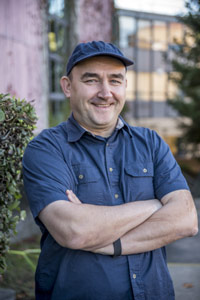
The need for more sophisticated diffraction gratings to go along with advances in x-ray instrumentation drove Voronov and his colleagues to look beyond traditional grating manufacturing techniques.
“New x-ray instrumentation requires more complicated, more precise, more sophisticated diffraction gratings than the existing manufacturing base can produce,” says Voronov. “So we started researching nanofabrication techniques to create alternative technology for manufacturing gratings.”
Nanofabrication gives scientists the ability to create tiny details with high precision. Typically, diffraction gratings for x-rays are made using diamond ruling or holographic techniques, but nanofabrication opens up a much higher level of precision. “We’ve been so fortunate to have the Molecular Foundry right around the corner here at Berkeley Lab,” says Voronov. “It’s allowed us to pursue various avenues of research using the best nanoscience facilities and techniques available.”
Voronov and his colleagues use optical lithography, e-beam lithography, nanoimprint lithography, plasma etch, vacuum deposition, and chemical etch techniques at the Foundry to develop advanced large-area nanofabrication process for gratings. “I have probably spent more time at the Molecular Foundry over these years than at the ALS,” says Voronov.
The diffraction gratings that Voronov has developed are currently in use at ALS Beamline 12.0.1, and further iterations of advanced grating are under development for future beamlines, including QERLIN, and for the ALS-U project. Voronov and colleagues have one patent on file for their gratings, and will most likely file another in the near future.
“Right now, the requirements for our gratings are so high that existing vendors can’t fulfill the orders,” says Voronov. “There are companies looking to use the technology we’ve developed, but they don’t have access to facilities like the Molecular Foundry to research and manufacture.”

